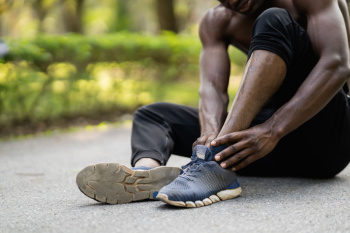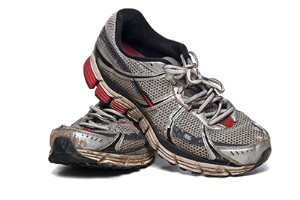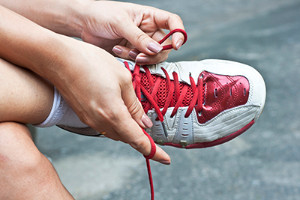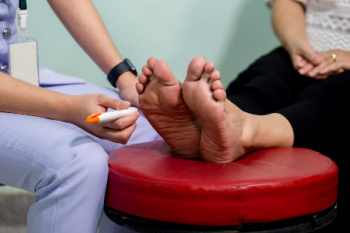Connect With Us
Blog
Items filtered by date: February 2024
Causes of Runners’ Heel Pain
 For avid runners, heel pain can be a significant obstacle, obstructing both performance and enjoyment of the activity. Heel pain can result from different factors including overuse, improper footwear, or biomechanical issues. The most common cause of heel pain for runners is plantar fasciitis, which is the inflammation of the tissue connecting the heel bone to the toes. Running, especially long-distance, puts strain on the plantar fascia and may lead to discomfort. Additionally, Achilles tendonitis, or inflammation of the Achilles tendon at the back of the heel, often causes pain for runners who escalate their training program too quickly. Heel spurs, bony outgrowths that can develop underneath the heel bone due to repetitive stress on the foot, are another hindrance for runners. Wearing ill-fitting or worn-out running shoes with inadequate support can also contribute to heel pain. If you are a runner with heel pain, it is suggested that you consult with a podiatrist who can offer a comprehensive evaluation, locate the source of the pain, and offer appropriate treatment methods.
For avid runners, heel pain can be a significant obstacle, obstructing both performance and enjoyment of the activity. Heel pain can result from different factors including overuse, improper footwear, or biomechanical issues. The most common cause of heel pain for runners is plantar fasciitis, which is the inflammation of the tissue connecting the heel bone to the toes. Running, especially long-distance, puts strain on the plantar fascia and may lead to discomfort. Additionally, Achilles tendonitis, or inflammation of the Achilles tendon at the back of the heel, often causes pain for runners who escalate their training program too quickly. Heel spurs, bony outgrowths that can develop underneath the heel bone due to repetitive stress on the foot, are another hindrance for runners. Wearing ill-fitting or worn-out running shoes with inadequate support can also contribute to heel pain. If you are a runner with heel pain, it is suggested that you consult with a podiatrist who can offer a comprehensive evaluation, locate the source of the pain, and offer appropriate treatment methods.
Many people suffer from bouts of heel pain. For more information, contact Kevin Powers, DPM of The Center for Lower Extremity Nerve Surgery. Our doctor can provide the care you need to keep you pain-free and on your feet.
Causes of Heel Pain
Heel pain is often associated with plantar fasciitis. The plantar fascia is a band of tissues that extends along the bottom of the foot. A rip or tear in this ligament can cause inflammation of the tissue.
Achilles tendonitis is another cause of heel pain. Inflammation of the Achilles tendon will cause pain from fractures and muscle tearing. Lack of flexibility is also another symptom.
Heel spurs are another cause of pain. When the tissues of the plantar fascia undergo a great deal of stress, it can lead to ligament separation from the heel bone, causing heel spurs.
Why Might Heel Pain Occur?
- Wearing ill-fitting shoes
- Wearing non-supportive shoes
- Weight change
- Excessive running
Treatments
Heel pain should be treated as soon as possible for immediate results. Keeping your feet in a stress-free environment will help. If you suffer from Achilles tendonitis or plantar fasciitis, applying ice will reduce the swelling. Stretching before an exercise like running will help the muscles. Using all these tips will help make heel pain a condition of the past.
If you have any questions please contact our offices located in Indianapolis and Bloomington, IN . We offer the newest diagnostic and treatment technologies for all your foot and ankle needs.
Wounds That Don't Heal Need to Be Checked
Distinguishing Between Walking and Running Shoes

Differentiating between walking and running shoes is essential for optimizing comfort and performance during physical activity. While both types of shoes may appear similar, subtle design features cater to the distinct biomechanics and movement patterns associated with each activity. Running shoes typically feature more cushioning and support in the heel and forefoot to absorb impact and provide stability during high-impact movements. They also tend to have a more flexible sole to facilitate the rolling motion of the foot from heel to toe. In contrast, walking shoes prioritize flexibility in the forefoot and emphasize support and stability throughout the midsole to accommodate the heel-to-toe motion of walking. Additionally, walking shoes often have a lower profile and lighter weight compared to running shoes. Understanding these differences allows individuals to select the appropriate footwear for their preferred activity, ensuring optimal comfort, support, and injury prevention during walking or running endeavors. If you have more specific questions about what type of shoes to buy for your walking or running experiences, it is suggested that you consult a podiatrist.
For more information about walking shoes versus running shoes, consult with Kevin Powers, DPM from The Center for Lower Extremity Nerve Surgery. Our doctor can measure your feet to determine what your needs are and help you find an appropriate pair of footwear.
Foot Health: The Differences between Walking & Running Shoes
There are great ways to stay in shape: running and walking are two great exercises to a healthy lifestyle. It is important to know that running shoes and walking shoes are not interchangeable. There is a key difference on how the feet hit the ground when someone is running or walking. This is why one should be aware that a shoe is designed differently for each activity.
You may be asking yourself what the real differences are between walking and running shoes and the answers may shock you.
Differences
Walking doesn’t involve as much stress or impact on the feet as running does. However, this doesn’t mean that you should be any less prepared. When you’re walking, you land on your heels and have your foot roll forward. This rolling motion requires additional support to the feet.
Flexibility – Walking shoes are designed to have soft, flexible soles. This allows the walker to push off easily with each step.
If you have any questions, please feel free to contact our offices located in Indianapolis and Bloomington, IN . We offer the newest diagnostic and treatment technologies for all your foot care needs.
Running Shoes for Different Types of Terrains

Running requires minimal gear, with a good-fitting pair of shoes as the essential requirement. Additional running accessories like well-constructed and breathable socks, gear, and watches are optional. However, your choice of running shoe can vary depending on your running conditions and preferences. To determine how many running shoes you need, start with at least one pair that suits you. Having two pairs and rotating them is beneficial for those running on the same terrain frequently, especially if it is several times a week. If you diversify your running terrain, you may consider purchasing additional pairs, as specific shoes cater to trails, tracks, speed workouts, and everyday runs. Trail shoes are suitable for rugged or slippery trails, providing waterproofing and extra traction. Track shoes, lightweight with minimal cushioning, benefit those preparing for track races or track workouts. Treadmill shoes should be cushioned, while speed work and race day shoes are designed to boost confidence and speed. Depending on your running goals and variety of terrain, you may need multiple shoes to optimize your training and performance. If you run or plan to run on different terrains, it is suggested that you schedule an appointment with a podiatrist to discuss how many pairs of running shoes may be suitable for your running goals.
If you are a runner, wearing the right running shoe is essential. For more information, contact Kevin Powers, DPM from The Center for Lower Extremity Nerve Surgery. Our doctor can provide the care you need to keep you pain-free and on your feet.
Choosing the Right Running Shoe for Your Foot Type
To increase performance and avoid the risk of injury, it is important to choose the right running shoe based on your foot type. The general design of running shoes revolves around pronation, which is how the ankle rolls from outside to inside when the foot strikes the ground.
- Neutral runners are able to choose from a wide variety of shoes, including minimalist shoes or even going barefoot.
- Runners who overpronate, or experience an over-abundance of ankle rolling, should choose shoes that provide extra motion control and stability.
- Runners who underpronate, or supinate, have feet that have high arches and lack flexibility, preventing shock absorption. They require shoes with more flexibility and cushion.
If you have any questions please feel free to contact our offices located in Indianapolis and Bloomington, IN . We offer the newest diagnostic and treatment technologies for all your foot and ankle needs.
Facts About Peripheral Neuropathy

Peripheral neuropathy, commonly associated with diabetes, is nerve damage that primarily affects the extremities, especially the feet and legs. Symptoms of peripheral neuropathy include burning, tingling, numbness, pain, and weakness. These often worsen at night and lead to balance issues and difficulty walking. Peripheral neuropathy can increase the risk of foot problems, such as blisters and sores, that go unnoticed. This can result in severe infections, ulcers, or even loss of limb if left untreated. Diagnosis by a podiatrist involves medical history, physical examination, and tests like neurological exams and foot sensation assessments. Prevention entails meticulous diabetes management, regular foot care, and prompt treatment of any foot issues. Collaboration with healthcare professionals, especially a podiatrist, is vital for effective management of peripheral neuropathy. In order to improve and preserve foot health, it is suggested that you are under the care of a podiatrist who is medically trained to treat this condition.
Neuropathy
Neuropathy can be a potentially serious condition, especially if it is left undiagnosed. If you have any concerns that you may be experiencing nerve loss in your feet, consult with Kevin Powers, DPM from The Center for Lower Extremity Nerve Surgery. Our doctor will assess your condition and provide you with quality foot and ankle treatment for neuropathy.
What Is Neuropathy?
Neuropathy is a condition that leads to damage to the nerves in the body. Peripheral neuropathy, or neuropathy that affects your peripheral nervous system, usually occurs in the feet. Neuropathy can be triggered by a number of different causes. Such causes include diabetes, infections, cancers, disorders, and toxic substances.
Symptoms of Neuropathy Include:
- Numbness
- Sensation loss
- Prickling and tingling sensations
- Throbbing, freezing, burning pains
- Muscle weakness
Those with diabetes are at serious risk due to being unable to feel an ulcer on their feet. Diabetics usually also suffer from poor blood circulation. This can lead to the wound not healing, infections occurring, and the limb may have to be amputated.
Treatment
To treat neuropathy in the foot, podiatrists will first diagnose the cause of the neuropathy. Figuring out the underlying cause of the neuropathy will allow the podiatrist to prescribe the best treatment, whether it be caused by diabetes, toxic substance exposure, infection, etc. If the nerve has not died, then it’s possible that sensation may be able to return to the foot.
Pain medication may be issued for pain. Electrical nerve stimulation can be used to stimulate nerves. If the neuropathy is caused from pressure on the nerves, then surgery may be necessary.
If you have any questions, please feel free to contact our offices located in Indianapolis and Bloomington, IN . We offer the newest diagnostic and treatment technologies for all your foot care needs.

